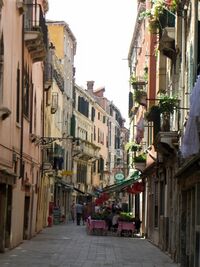Streets
| This page may require cleanup to meet Venipedia's quality standards. Please edit the article and fix the problems. |
| This page may require copy editing for grammar, style, cohesion, tone, or spelling. Please improve the article now. |
| Please help improve this article by expanding it. |
| This page needs more historical information. Please help improve this article by adding some. |
This article contains information about all of the streets in Venice.
 A typical venetian Street | |
| Number | 2650 |
|---|---|
| Total Length | 157 km |
| Total Area | 1.14 km^2 |
| Longest | Viale IV Novembre |
| Widest | Riva Ca' di Dio |
The historical center of Venice contains 2,650 named streets, stretching a total of 157 Km. The Venetian streets are unique to the city because of their historic Paving Stones and the elaborate methods of maintaining and laying down the various Paving Patterns seen around the city.
History
Venice was built unlike any other Italian town. The formation of streets in Venice was not a planned process,as buildings were constructed the area in between them became streets. All of these original streets were dirt pathways with the exception of a few main streets which were paved with brick. Paved streets are referred to as Salizada. In present day Venice there are no more dirt streets. Most streets are paved with quarried Trachyte stones (Masegno). Only 2% of Street Pavement in Venice is still made of Brick. The streets in Venice are oddly shaped and bordered by either towering buildings or canals, which make the streets difficult to navigate, giving rise to the nickname "the tourist maze"[1].
Map
Link [1] to the original GIS map file.
See Also
References
- ↑ Davis, Robert. Venice, The Tourist Maze. Los Angeles, CA: University of Californis Press, 2004.
Bibliography
External Links
NULL